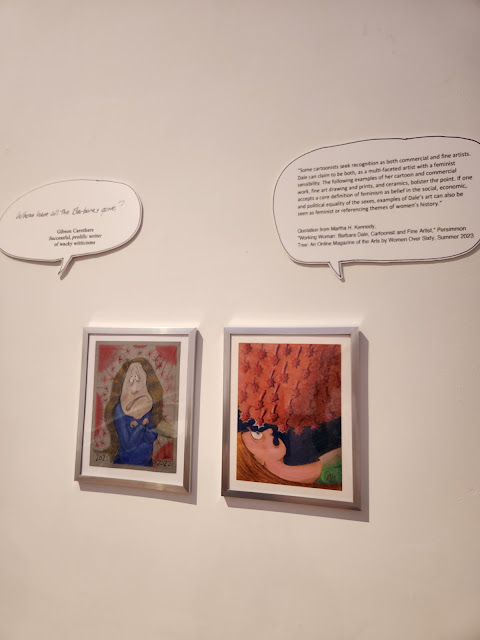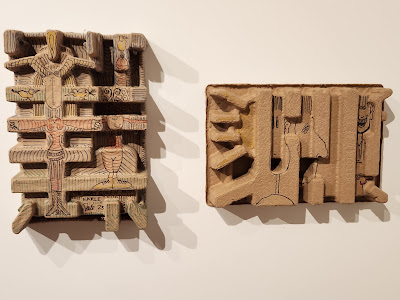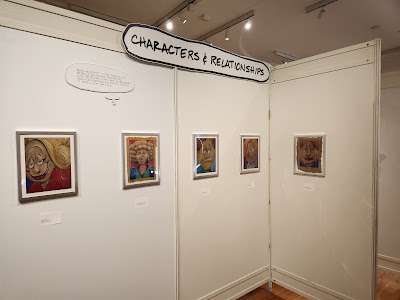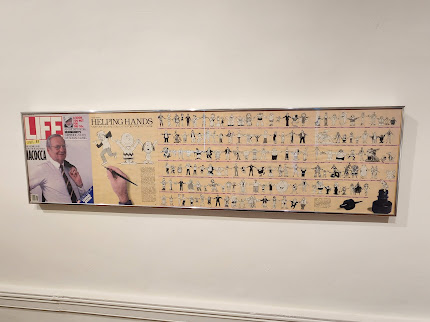California Institute of Integral StudiesAlison Halsall. Growing
Up Graphic: The Comics of Children in Crisis. Ohio State University Press,
2023. https://ohiostatepress.org/books/titles/9780814215548.html
Growing
Up Graphic: The Comics of Children in Crisis is a refreshing
and honest assessment of the importance of accurately and frankly acknowledging
that childhood innocence is a Western invention. And also, that children, no
matter where they are from or who they are, deserve to see themselves depicted
in comics and can use the graphic narrative medium as a means to develop a
broader and more realistic world view. Alison Halsall, fresh off the success of
her edited volume The LGBTQ+ Comics Studies Reader winning the 2023
Eisner Award for Best Academic/Scholarly Work, writes Growing Up Graphic with
four objectives in mind. First, Halsall aims to explore comics and graphic
narratives as a medium heavily invested in representing the reality of the
social, political, and cultural experiences of childhood and youth. Graphic
narratives, she argues, are a particularly useful means of sharing these
experiences across national and cultural borders, because the “unique
verbal/visual interface” (28) of these narratives seems to translate across the
borders more easily. The second objective is the navigation of comics for young
people throughout, within, and around “discourses of nation, belonging, ableism,
and identity” (3). Young people are shaped by the communities and countries in
which they live, and the politics of those spaces, and they deserve to have a
space in that discourse. Third, she observes and contends with the trend in
children’s publishing to diversify published content, providing young readers
in the Global North with a more intersectional lens through which to see the
world when consuming media. Comics and graphic narratives for children use the
personal and the local to aid young readers in understanding broader
narratives. And finally, she considers the readers themselves as a source of
tension. Halsall meets all her stated objectives with aplomb and a frankness
that makes the book hard to put down.
Halsall’s text refutes the harmful ideas that comics and
graphic novels are somehow lesser and should not be consumed by children or
young people because of supposedly harmful and corrupting influences. This idea
has existed for decades; today’s censorship of LGBTQ and African-American graphic
novels echoes Fredric Wertham’s 1950s crusade against comics. However, Halsall argues that the world in which we all
live requires more and more of
children, particularly in terms of communication and critical thinking skills.
Visual literacy, comprehension, and interpretation are increasingly necessary
aspects of communication. More libraries, schools, and curricula for young
readers find the navigation of graphic texts to be a valuable means by which
students and readers can develop these and other skills, while also developing
a love of literature, art, and reading from a young age. Not only do graphic
narratives provide opportunities for young readers to develop the
aforementioned skills, but the particular graphic narratives Halsall addresses
in Growing Up Graphic (which include such titles as War Brothers by
Sharon E. McKay, Leila Abdelrazaq’s Baddawi, 7 Generations by
David Alexander Robertson, and several of Raina Telgemeier’s graphic novels,
including Guts and Drama) provide young readers with new and
engaging opportunities to learn about human rights discourses, world events,
and ways in which children are and can be active agents in the world around
them, providing the groundwork for those readers to become more empathetic,
compassionate, and culturally aware.
Furthermore,
Halsall questions the Global North belief that childhood and youth are and must
be innocent – that children should be protected from anything that may burden
the innocence of their youth. Childhood, Halsall argues, is a largely Western
concept, and that the Global North conception of childhood as something which
should be stable and protected is in conflict with the experiences of hundreds
of thousands of children both within the context of Western societies and
beyond. This conflict is present throughout all five chapters of Growing Up
Graphic.
In
her first chapter, Halsall explores the use of childhood in war, bringing the
reader through an analysis of Michel Chikwanine’s Child Soldier: When Boys
and Girls Are Used in War, Sharon E. McKay and Daniel Lafrance’s War
Brothers: The Graphic Novel, and Jean-Philippe Stassen’s Deogratias, A
Tale of Rwanda to ask readers to reflect on the ontology of victimhood, the
lives of those – especially children – who are caught up in wars not of their
own making, and the impacts of power, control, and change. She calls upon these
texts to defamiliarize standard historical narratives and the ideas of
childhood, as they instead point out that history is far rifer with personal
and political violence and trauma, and that childhood “transforms in relation
to war, a social and political crisis” (34). The children involved in armed
conflict cannot be seen from the Western perspective of childhood as brimming
over with innocence, they are shown through these narratives to be complex;
neither agents nor at-risk victims, but perhaps both at the same time. They can
be agentic without being responsible, vulnerable without being entirely
victimized, etc.
This
vein of complicated agency continues into the second chapter, with a question
of how graphic narratives about immigration, diaspora, and refugees, such as
Morten Dürr and Lars Horneman’s Zenobia, Shaun Tan’s The Arrival,
Matt Hyunh’s “The Boat,” Reinhard Kleist’s An Olympic Dream: The Story of
Samia Yusuf Omar, Leila Abdelrazaq’s Baddawi, and George Takei’s They
Called Us Enemy, can explore migration ethically, rejecting the instinct
common in Western literature to represent refugees and immigrants as “passive
victims waiting to be ‘saved’” (58), instead exploring them as fully complex individuals
shaped by the circumstances in which they find themselves. This effort
humanizes the refugee crisis and the protagonists of these texts, allowing
young readers to ground themselves in another young person’s lived experiences.
“Here” and “there” become less disparate as young readers read, and they are
able to conceptualize immigrants and refugees as something more than victims
without agency, awaiting saving from the Global North.
The
theme of agency and refusing to see marginalized protagonists as victims in
need of saving continues throughout the text. Chapter 3 of Growing Up
Graphic focuses on Indigenous texts from Canada, exploring the way that
texts such as Katherena Vermette’s A Girl
Called Echo, David Alexander Robertson’s 7 Generations, and Michael Nicoll Yahulanaas’s Red: A Haida Manga explore the healing powers of language and
visual storytelling to explore myth and worldview, and address the generations
of systemic violence and genocide faced by Indigenous communities. While this
chapter addresses and acknowledges injustices, both past and present, the texts
analyzed within seek to empower Indigenous youth, providing a narrative that
emphasizes cultural affirmation, renewal, and hope while responding to a
history of colonial violence. The texts encourage young readers to question
historical narratives, resist the erasure of violence and colonialism, and work
against the continued racial stratification and systematic injustices. Not only
does the use of graphic narrative offer Indigenous writers and readers
catharsis and critical reflection, but it also provides non-Indigenous young
readers with valuable perspective while not viewing Indigenous peoples
non-agentic or their lives and stories as something to be relegated to a
history book.
Chapter
4 takes particular umbrage at the concept of protecting the innocence of
childhood by highlighting the powerful importance of quality representation of
queer identity in texts for young readers, complicating the idea that children
must be separated from any knowledge of sexuality. Halsall argues against both
an ideal of a stable, protected childhood and a stable sexual and gender
identity, acknowledging that both of these concepts are likely to fluctuate,
change, and have different meaning for different people over time. She examines
texts such as Mariko Tamaki’s Laura Dean Keeps Breaking Up with Me, Hubert
and Marie Caillou’s Adrian and the Tree of Secrets, and Ngozi Ukazu’s Check,
Please! to understand how they normalize the queer experience, reorienting
the narrative of queer media away from the trauma and crisis often associated
with queerness to the conflict ubiquitous in young people’s interpersonal
relationships. The context of this chapter within the rest of Growing Up
Graphic is interesting, because the texts Halsall examines here are creating
narratives wherein existing as queer is not, inherently, a crisis. However, the
texts themselves are seen as a crisis, as political and cultural groups
continue to try to protect young people from anything perceived as sexual. Such
groups harken back to “the pervasive myth of the implied Romantic child reader,
whose purity is necessarily incompatible with sexual awareness and experience”
(131) and consider such texts inappropriate for young readers. These texts,
however, are continually and increasingly important for readers, as they seek
to orient themselves in relation to the world around them and develop broader
views on many issues.
All
of the texts encourage perspective taking, empathy, and compassion in their
readers, and the fifth chapter’s emphasis on health crises furthers this
objective, while also often providing information, awareness building, and
consciousness raising about what are often otherwise undiscussed parts of
people’s lives, especially when those in the midst of the health crisis are
young people. Texts such as Raina Telgemeier’s Guts or Smile,
Cece Bell’s El Deafo, and Tory Wollcott’s Mirror Mind: Growing Up
Dyslexic provide the creator and perhaps the reader with some measure of
control over what can often be a situation in which the person affected has
little to no control. Not only does Halsall address the way these texts can
normalize experience of bodily difference, chronic and/or severe illness, or
mental variance, she also speaks to the way that the texts respond to the
silence around many of these conditions, redefine the meaning of health, and affirm
the agency of those who may have such a condition, especially in the face of
families or medical professionals who may attempt to remove such agency or
voice. Halsall returns to the message of refuting the victim paradigm,
emphasizing texts that move away from the protagonist needing rescue from their
condition. Not only do graphic narratives provide the same benefit of
socio-emotional education around disability that they do the other topics
discussed in Growing Up Graphic, but Halsall also points out the ways in
which graphic narratives as a whole can be an accessible form of learning for
those with developmental disorders, learning disabilities, or other conditions
that may impact information acquisition, retention, understanding, and/or
processing (179). These graphic narratives challenge the idea of children as apolitical
and needing protection from troubling topics such as health crises or
disability, instead giving children the language necessary to approach medicine
and their bodies with agency and information.
Halsall
leaves the reader anticipating more – more comics and graphic narratives, more
from comics studies, more from Halsall herself, and, unfortunately but
realistically, more children in crisis. She concludes with an impact statement
about how the COVID crisis has highlighted discrimination in a variety of forms
across the globe and the unequal distribution of safety and power across homes
and nations, and the ways in which graphic narratives are already being used to
address various aspects of the pandemic. Still Halsall asserts, the children
don’t need protecting from the realities of COVID any more than they do from
other world crises, they need understanding, information, an outlet, and
compassion. From an explosion of digitally available comics about the
experiences of people during the course of the ongoing pandemic, to being used
to provide information about mitigating the risks of the virus, Halsall
anticipates that COVID comics will continue to prove all the ways in which
comics provide young readers with a humanizing glimpse into the experiences and
challenges faced by young people all the world over.







































































































































